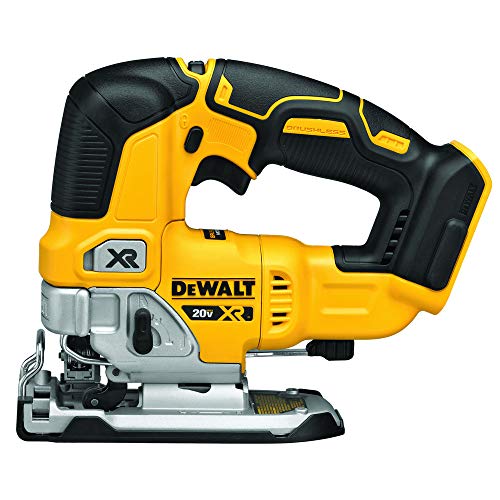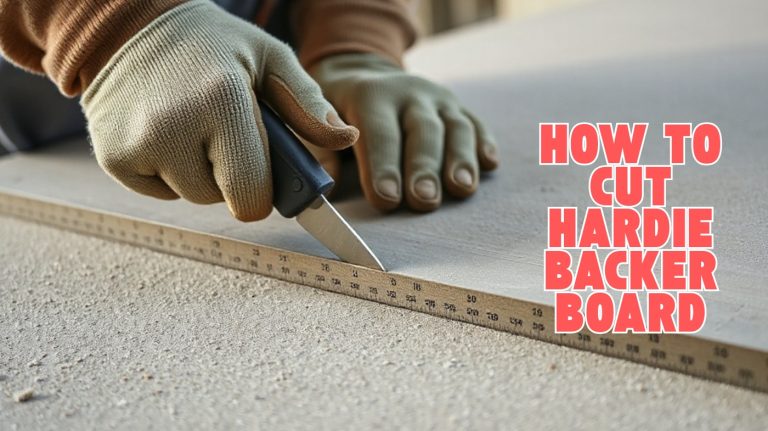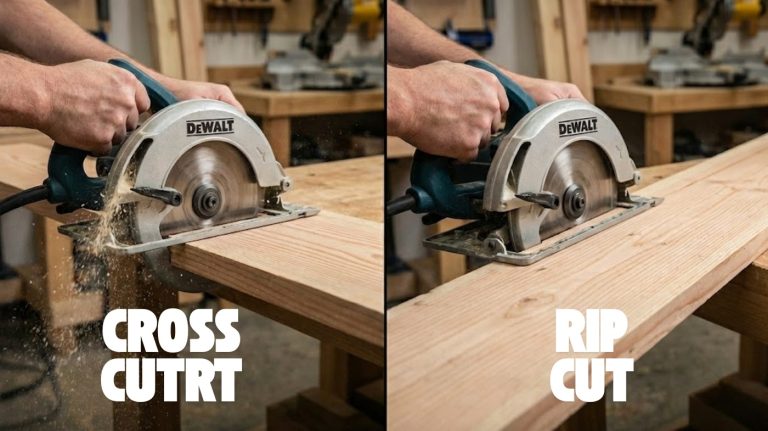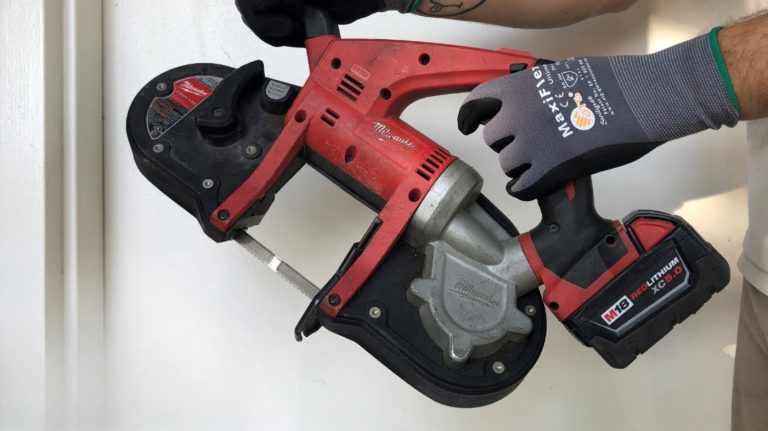Jigsaw vs Bandsaw: Find Out Which One Suits Your Projects
If you need portability and tight, intricate cuts on thin materials, a jigsaw is your go-to tool. It’s handheld, lightweight, and excels at curves and detailed shapes up to about 2 inches thick.
On the other hand, a bandsaw handles much thicker stock—over 6 inches—with superior stability, power, and precise straight or gentle curved cuts, ideal for heavy-duty resawing in a stationary setup. Understanding their distinct strengths helps you choose the right tool for your specific project needs.
- Brushless motor of the cordless jigsaw delivers efficient performance for longer runtime (vs. DCS331…
- Compact size for easy grip and maximum control of the jig saw
- Bright LED on the jigsaw tool helps illuminate dimly lit work surfaces
- 2.8-amp motor rotates the blade up to 2500 feet per minute
- Create cuts up to 3-1/2 inches deep and 9 inches wide
- Uses 59-1/2-inch blades anywhere from 1/8 to 3/8 inches in size
Key Takeaways
- Jigsaws excel at intricate, tight curves and detailed cuts on thinner materials, while bandsaws handle thicker, larger stock and smoother curves.
- Bandsaws provide greater cutting depth (6-12 inches) suitable for resawing and large boards; jigsaws are limited to about 1-2 inches.
- Jigsaws are portable and lightweight for on-site use; bandsaws are stationary machines designed for workshop stability and heavy-duty repetitive cuts.
- Bandsaws offer superior cut precision and stability with continuous blade motion, while jigsaws may produce rougher edges due to blade vibration.
- Jigsaws are more affordable with easier maintenance; bandsaws require higher initial investment but have durable build and lower long-term blade costs.
Quick Comparison Table: Jigsaw and Bandsaw at a Glance
| Feature | Jigsaw | Bandsaw |
|---|---|---|
| Blade Type & Movement | Short, thick, reciprocating (up-and-down) | Long, narrow, continuous loop rotation |
| Portability | Portable, handheld, often cordless | Stationary, workshop-based |
| Cutting Capacity | Thin materials, up to 2 inches thick | Thick materials, 6 inches or more |
| Cut Types | Intricate, tight curves and detailed cuts | Straight and gentle curves, heavy-duty |
| Cutting Stability | Less stable, prone to vibration | High stability, smooth, precise cuts |
| Maintenance | Easy blade replacement, affordable blades | Requires blade tensioning, sharpening |
| Best Use | Portable jobs, detailed shaping | Resawing, thick stock cutting |
Comparing Functionality and Use Cases
When comparing functionality and use cases, you’ll find that jigsaws and bandsaws cater to different cutting needs based on their design and capabilities. You’ll rely on a jigsaw for intricate, narrow cuts and tight curves, making it ideal for detailed work on various materials like wood, metal, or plastic.
Its handheld design lets you maneuver in tight spaces and cut at different angles. Additionally, its lightweight and handheld nature emphasizes portability and ease of transport, making it convenient for on-site jobs. Bandsaws typically feature a 1 HP motor or higher, providing the power necessary for cutting thick materials efficiently.
Conversely, bandsaws excel at cutting thicker materials and resawing large stock with consistent, precise straight cuts. You’ll use a bandsaw in a stationary workshop setting for heavy-duty, repetitive cutting tasks requiring stability and power. While both can cut curves, bandsaws handle larger radius curves, whereas jigsaws provide better control on complex shapes and finer detail cuts.
Design and Blade Movement Differences
Although both jigsaws and bandsaws serve cutting purposes, their structural designs and blade movements differ fundamentally, directly influencing their performance and application.
You’ll notice the jigsaw uses a short, reciprocating blade, perfect for handheld detailed cuts, while the bandsaw employs a long, continuous blade rotating around wheels, ideal for stable, uniform cuts. The choice of blade material can also significantly affect cutting quality and blade longevity for both tools.
| Feature | Jigsaw | Bandsaw |
|---|---|---|
| Blade Type | Short, thick, reciprocating | Long, narrow, continuous loop |
| Blade Movement | Vertical up-and-down (+ orbit) | Continuous rotation |
| Machine Mobility | Portable (corded/cordless) | Stationary |
| Cutting Stability | Less stable, prone to vibration | High stability, less vibration |
This design contrast shapes your choice based on cut complexity and work environment. Additionally, the blade orbit feature in jigsaws allows for adjustable pendulum movement that can enhance cutting speed and quality on softer materials.
Material Thickness and Cutting Capacity
Since material thickness directly impacts cutting performance, understanding the capacity differences between jigsaws and bandsaws is essential.
Bandsaws handle much thicker materials—commonly over 6 inches—thanks to long, continuous blades and adjustable throat depths. This allows you to cut thick lumber, perform resawing, and rip large boards, tasks jigsaws simply can’t manage due to their limited blade length (under 3 inches) and up-and-down blade motion.
Their ability to perform resawing is a unique advantage not found in jigsaws. Many bandsaws also feature robust construction that supports heavy-duty cutting tasks. Jigsaws excel with thinner stock and sheet materials where thickness remains below their blade capacity.
Additionally, bandsaws accommodate large, bulky workpieces by letting you push material through a stationary blade, while jigsaws require moving the tool, limiting size and stability.
For cutting dense or thick materials, bandsaws provide superior power and blade tensioning, whereas jigsaws are better suited for lighter, thinner applications.
Precision and Quality of Cuts
Understanding precision and quality of cuts is crucial when choosing between a jigsaw and a bandsaw, as each tool offers distinct advantages depending on your project requirements.
Bandsaws provide superior accuracy for straight and gentle curve cuts by stabilizing the workpiece on a table and guiding it with fences, minimizing blade deflection and vibration. This setup ensures consistent dimensional stability and smooth edge finishes, especially on larger pieces.
Additionally, bandsaws are well-suited for resawing and cutting thicker wood, which enhances their versatility for heavy-duty tasks. Proper maintenance such as blade tension adjustment is essential to reduce vibration and maintain cutting accuracy.
Conversely, jigsaws excel in intricate, tight curves and interior cuts due to their handheld maneuverability and thinner blades, though they sacrifice repeatability and often leave rougher edges requiring finishing.
While jigsaws demand more operator skill to maintain alignment, bandsaws offer better control over blade speed and feed rate, enabling enhanced surface quality and precision in production or repeat cuts.
Portability and Workspace Needs
When you need a tool that moves with you, a jigsaw stands out for its portability and minimal workspace demands. Handheld and often cordless, it lets you work directly on large or irregular pieces without relocating materials.
Its compact size fits easily on any stable surface, requiring less dedicated space and enabling quick setup. Additionally, jigsaws are versatile with variable speed controls, allowing users to adjust the blade speed for different materials and cut types.
In contrast, bandsaws are stationary, benchtop, or floor-standing machines demanding substantial, stable workspace and a constant power source. Their heavier design restricts mobility, confining them to workshop environments with ample room for safe operation.
While bandsaws excel in repetitive, precise cuts on thick stock, their size and setup complexity make them less practical for on-site or space-limited tasks where jigsaws offer superior flexibility and ease of use.
Blade Types and Maintenance Requirements
You’ll find jigsaw blades come in various steels like HCS, HSS, and BIM, each designed for specific materials and cut types. It is important to select blades with the appropriate tooth geometry to match the cut type and material. While bandsaw blades range from carbon steel to bi-metal with different back treatments for flexibility or stiffness.
Maintenance differs accordingly: jigsaw blades wear faster on hard materials and need frequent replacement, whereas bandsaw blades require regular tension checks and sharpening to maintain precision. Proper cleaning, alignment, and annealing are essential steps to ensure the reliability of welded bandsaw blades.
Blade Variations
How do blade types and their maintenance impact the performance of jigsaws and bandsaws? Jigsaw blades, typically short and narrow, come in HCS, HSS, and bi-metal variants, each tailored to specific materials—from softwood to metals.
Tooth design, such as milled & side set for fast cuts or ground & taper ground for fine finishes, directly affects cut quality and vibration. Regular maintenance like cleaning and sharpening is essential to sustain blade life and cut efficiency. Bandsaw blades, longer and available in carbon steel, bi-metal, hard back, and flex back, vary in stiffness and flexibility for straight or curved cuts.
Tooth per inch (TPI) ranges from coarse for thick stock to fine for thin metals, influencing speed and surface finish. Proper blade width in bandsaws supports cut precision and radius, whereas jigsaws prioritize maneuverability.
Selecting the correct blade type ensures best cutting performance across materials and applications. It is also important to select blade width according to the project and saw capabilities to optimize performance. Additionally, matching blade width to motor power ensures optimal saw performance and longevity.
Maintenance Needs
Although bandsaw and jigsaw blades serve similar cutting functions, their maintenance demands differ considerably due to design and operational complexity. Bandsaw blades need regular tension adjustments and cleaning to remove pitch buildup, preventing dullness and damage to tires and bearings.
You must also monitor blade feeding speed and pressure closely to avoid wear and deflection. Additionally, the choice of blade size, type, and teeth per inch significantly influences the bandsaw’s cutting accuracy and material compatibility. Applying lubricant after cleaning also helps maintain smooth operation and prolongs blade life.
In contrast, jigsaw blades require straightforward inspection and prompt replacement when worn, thanks to their simple clamp system and shorter length.
Keep these points in mind for effective blade maintenance:
- Bandsaw blades require tension checks, lubrication, and periodic sharpening.
- Jigsaw blade maintenance focuses on quick inspection and replacement.
- Proper storage avoids tension on bandsaw blades, preserving machine components.
Handling Curves and Complex Shapes
When handling curves and complex shapes, jigsaws offer superior versatility for intricate, tight-radius cuts that bandsaws simply can’t match.
Their narrow, up-and-down moving blades let you navigate sharp interior cuts and detailed patterns, including holes or cutouts started from drilled openings. Jigsaws’ handheld design also provides portability and design features that enhance user convenience on varied projects.
Conversely, bandsaws excel at wider, smoother curves on thicker stock but struggle with tight radii due to blade width and continuous loop motion. Since bandsaws are stationary, you must physically maneuver the workpiece within the throat size, limiting large or awkward materials. The bandsaw is also ideal for restoring or re-sawing large stock, providing greater versatility in woodworking tasks.
Jigsaws, being handheld, allow you to cut large pieces in place with greater control over complex shapes. However, jigsaws perform best on thinner stock, while bandsaws better handle thick hardwood and metal, though with less precise curve details. Additionally, motor power and performance play a key role in how effectively these tools handle different material thicknesses and cutting demands.
Resawing and Thick Stock Capabilities
When you need to resaw thick wood or handle wide stock, the bandsaw outperforms the jigsaw with its superior cutting depth and blade design. Proper blade lubrication can further enhance the bandsaw’s cutting efficiency and blade lifespan.
The bandsaw’s continuous blade loop allows smooth vertical cuts through large lumber, while the jigsaw’s limited blade length restricts it to thinner materials.
Additionally, the bandsaw is better suited for projects requiring precise, stable cuts and can handle more complex woodworking tasks efficiently.
Resawing Thick Wood
How do bandsaws and jigsaws compare in their ability to resaw thick wood? Bandsaws are clearly superior for resawing thick stock. Their thick, rigid blades and powerful motors allow you to slice large lumber into thinner slabs efficiently and with precision.
Jigsaws, on the other hand, have short, flexible blades and weaker motors, limiting their cutting depth and making resawing impractical. You’ll struggle with blade wander and uneven cuts if you try resawing thick wood on a jigsaw.
- Bandsaws use wide, stable blades designed for deep cuts and reduced deflection.
- Jigsaws rely on reciprocating blades that can’t maintain straight cuts in thick stock.
- Bandsaws’ continuous blade contact and higher motor power enable smooth, controlled resawing.
For optimal results, choosing blades with precision ground teeth designed for stability and reduced vibration is essential when resawing thick wood.
Cutting Depth Comparison
Although both bandsaws and jigsaws serve as versatile cutting tools, their cutting depth capabilities differ considerably, especially for resawing and handling thick stock. Bandsaws typically offer cutting depths from 6 to 12 inches, supported by a continuous loop blade, heavy base, and stable table, allowing you to make consistent, precise deep cuts through thick or crooked lumber.
This design supports resawing and thick stock processing without compromising blade lifespan. In contrast, jigsaws limit you to about 1 to 2 inches of cutting depth due to shorter blades and handheld operation.
Making them unsuitable for thick materials or resawing. The reciprocating blade and user-applied pressure reduce cut precision and tool control, increasing blade wear when forced beyond ideal depths. For deep, repetitive cuts in thick stock, bandsaws clearly outperform jigsaws.
Handling Wide Stock
Bandsaws excel at handling wide and thick stock, making them ideal for resawing tasks that exceed the capabilities of jigsaws. Their large throat size and continuous band blade let you pass wide, thick boards smoothly, slicing slabs into thinner sections with precision.
You can adjust blade guides and tension to prevent deflection, ensuring clean, straight cuts. Many benchtop bandsaws, like the Craftsman 21400 and JET JWBS-10OS, feature adjustable blade guides and tension scales that improve cutting accuracy and ease of use.
Jigsaws, meanwhile, struggle with thick or wide material due to their short, reciprocating blades and limited throat capacity.
- Bandsaws provide stable blade contact for wide resawing without binding or heat buildup.
- Adjustable fences and tables support consistent, fatigue-reducing cuts on large stock.
- Jigsaws excel on thin, curved cuts but can’t handle wide or thick resawing efficiently.
For wide stock, bandsaws deliver unmatched capacity and control.
Versatility Across Different Materials
When working across different materials, your choice between a jigsaw and a bandsaw considerably impacts both the range and quality of cuts you can achieve.
A jigsaw’s handheld design and blade interchangeability let you efficiently cut wood, softer metals, plastics, and laminates, making it highly versatile for on-site and variable material tasks. Its quick blade swapping feature allows seamless transitions between different cutting needs.
In contrast, bandsaws excel in handling thick wood and can be adapted with specialized blades for non-ferrous metals and some plastics, though they primarily serve woodworking.
Bandsaws deliver consistent, smooth cuts on large, bulky pieces but lack the jigsaw’s ability to pivot for tight internal curves or bevels.
Therefore, your material variety and cut complexity dictate whether the jigsaw’s adaptability or the bandsaw’s power and precision better suit your project’s demands.
Frequently Asked Questions
Can a Jigsaw Be Safely Used by Beginners?
You can safely use a jigsaw as a beginner by following essential safety protocols. Always wear certified safety goggles, sturdy gloves, and hearing protection.
Inspect the tool and blade before starting, ensuring the blade is sharp and properly installed.
Secure your workpiece on a stable surface with clamps.
Start cutting at a slow speed, letting the blade do the work without forcing it.
Keep your hands clear of the blade path to prevent injury.
What Safety Gear Is Recommended for Bandsaw Operation?
Imagine a sudden kickback or flying debris catching you off guard. To stay safe on a bandsaw, you’ll need safety glasses or goggles to shield your eyes, plus hearing protection like earplugs for noise. Consider a face shield for extra defense.
Wear snug clothing, tie back hair, and remove jewelry. Use gloves cautiously to avoid entanglement. Don’t forget protective footwear and verify machine guards are properly in place before you start.
How Noisy Are Bandsaws Compared to Jigsaws During Use?
You’ll find bandsaws typically produce a steady noise between 70-100 dB, depending on size and noise control features. Proper maintenance, like guide bearing adjustment, can reduce this sound considerably.
Jigsaws, on the other hand, generate variable, burst-style noise around 80-90 dB, with higher-frequency vibrations due to their reciprocating blades.
Both tools require hearing protection, but bandsaws’ continuous hum often demands more extensive noise reduction measures in workshops.
Are There Cordless Bandsaw Options Available?
You’ll find multiple cordless bandsaw models from top brands like Milwaukee and DeWalt, with cutting capacities up to 5 inches square in one pass. These tools often feature brushless motors for better efficiency and longer battery life, usually running on 18V or 20V lithium-ion platforms.
Compact versions handle smaller cuts around 2.5 inches. Cordless bandsaws combine portability with professional-grade power, making them ideal for versatile, on-the-go cutting tasks.
Can Either Saw Be Used for Metal Cutting Without Damage?
You can cut metal without damage if you use the right saw and blade combination. Choose blades specifically designed for metal, like bi-metal or carbide-tipped, and maintain sharpness.
Adjust cutting speed and feed rates to match metal thickness and type. Secure the workpiece firmly and avoid excessive force to prevent blade flex or overheating.
Proper technique and equipment ensure clean, precise cuts while minimizing blade and metal damage.
Make Smart Choices for Superior Woodworking Results
When choosing between a jigsaw and a bandsaw, think of them as different brushes in your woodworking palette. The jigsaw offers nimble precision for intricate curves and portability, while the bandsaw excels in cutting thicker stock and resawing with consistent power.
Understanding their design and cutting capacities guarantees you pick the right tool for your project’s demands, maximizing efficiency and quality without overspending. Choose wisely to sharpen your craft with confidence.
- High cutting efficiency– The 4-stage orbital function allows smooth cutting ability across…
- Speed control & brake–Variable speed control provides optimal cutting speed for all applications…
- Angled cutting– The shoe bevel adjustment allows you to cut at angles.
- Power Saws and Accessories
- Made in China
- This band saw is over 20% lighter than the original M18 Compact Band Saw
Last update on 2025-12-19 / Affiliate links / Images from Amazon Product Advertising API











